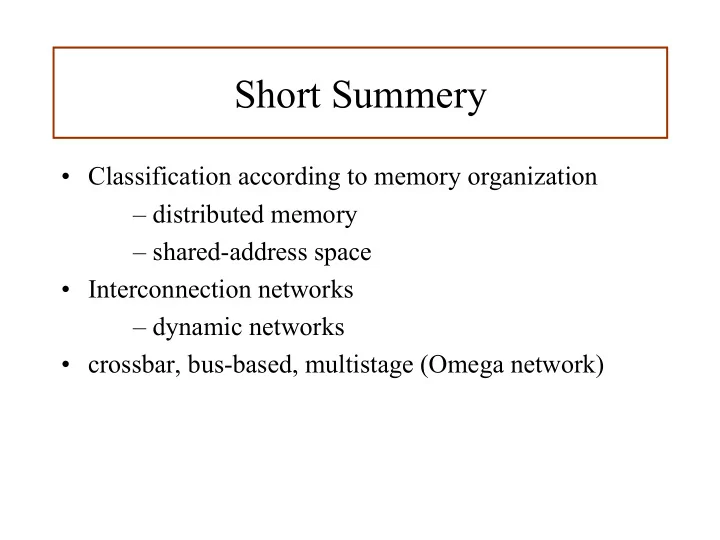

Short Summery • Classification according to memory organization – distributed memory – shared-address space • Interconnection networks – dynamic networks • crossbar, bus-based, multistage (Omega network)
Omega Network 2i, 0 <= i <= p/2 -1 j = 2i + 1 - p p/2 <= i <= p -1
Omega network features • There are log p stages each with p /2 switching elements each = p /2 * log p total – Contrast with Θ ( p 2 ) for the crossbar switch • Simple routing algrithm – At each stage, look at the corresponding bit (starting with the msb) of the source and destination address – If the bits are the same, messages passes through, otherwise is crossed-over • Omega networks are blocking networks - when routes to different memory banks share a link a message might be blocked by another – Contrast with nonblocking crossbar switch
Blocking in omega network • Example of blocking: either (010 to 111) or (110 to 100) has to wait until link AB is no lon g er in use
Static interconnection networks • Completely connected networks • Star-Connected Networks • Linear Array and Ring • Mesh Networks • Tree Networks • Hypercube Network
Static Interconnection Networks I • Completely [star] connected network is the static analogous of the crossbar [bus] interconnect Completely connected Star connected Linearly array Ring
Static Interconnection Networks II • A n-dimensional mesh [ torus or wraparound mesh ] is an extension of the linear array [ring] • Examples: Intel Paragon (2D mesh), Cray T3D (3D torus)
Tree networks Simple trees Fat tree
Hypercubes • An hypercube i s multi-dimensional mesh with exactly two processors in each dimension • Examples: Cosmic Cube, nCube 1, SGI Origin 2000
4D hypercube • 4D hypercube = two 3D hypecubes with an additional link connecting corresponding processors
Hypercube Gallery
Hypercube Property • One node connected to d others • One bit difference in labels <=> direct link • One hyper can be partitioned in two ( d-1 ) hypers • The Hamming distance = shortest path length – Hamming distance = # of bits that are different in source and dest = # of ones in source ⊕ dest • Each node address contains d bits – fixing k of these bits, the nodes that differ in the remaining ( d-k ) form ( d-k ) dimension subcube of 2 ( d-k ) nodes. There are 2 k such subcubes .
Subcube example • Subcubes of dimension 2 obtained by fixing the two most significant bits
K-ary d-cubes • A k -ary d -cube is a d -dimensional mesh with k elements along each dimension – k is called the radix , d the dimension – can be built from k -ary ( d-1 )-cubes by connecting the corresponding processors into a ring • Some of the other topologies are particular instances of the k -ary d -cube : – A ring interconnect with n nodes is a n -ary 1-cube – A two dimensional wraparound mesh of n 2 processors is a n -ary 2-cube
Recommend
More recommend